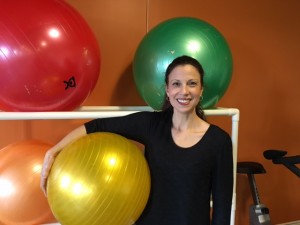Using Biofeedback in Pelvic Floor Physical Therapy
 This blog was written by Robyn Lowry, PT, MSPT.
This blog was written by Robyn Lowry, PT, MSPT.
Biofeedback is a fundamental tool for pelvic floor rehabilitation. Biofeedback can be used for both strengthening weak pelvic floor muscles (up training) as well as training tight shortened overactive pelvic floor muscles to relax (down training). Biofeedback is defined as “A training technique that enables an individual to gain some element of voluntary control over muscular or autonomic nervous system functions using a device that produces auditory or visual stimuli” (Schwartz 1987). Biofeedback makes physiological change possible through operant conditioning, a method of learning based on trial and error, rewards and punishment and reinforcement through repetition.
One of the most common statements made by my pelvic floor patients is “I had no idea I had muscles down there!” Very often they will tell me they had been instructed by a doctor or read in a magazine how to perform “Kegal” exercises to strengthen their pelvic floor but that they did not continue to do the exercises because they had no idea if they were performing them correctly. Studies show that 70% of women with pelvic floor muscle (PFM) dysfunction are not able to correctly contract their PFM with verbal instruction alone and as many as 30% of those women cause more harm with incorrect technique due to valsalva. (Bo, 2013) Biofeedback allows the patient to see exactly what their muscles are doing giving immediate feedback when they perform pelvic floor muscle strengthening exercises correctly or not. Once the brain to pelvic floor connection is made through biofeedback the patient is able to go home and repeat the exercises correctly and with greater confidence.
Biofeedback in the clinic has several advantages for both the patient and the therapist. For patients, biofeedback increases exercise interest, motivation and “buy in” which in turn produces better functional outcomes. It also gives patients an immediate sense of control over their pelvic floor functional performance, improves proprioceptive and sensory awareness critical to pelvic floor rehabilitation and increases patient compliance with their home exercise program. For clinicians, biofeedback provides a valuable source of objective information that can be documented and it provides meaningful criteria for exercise progression and modification.
Biofeedback can vary widely in pelvic floor physical therapy. It can be as simple as teaching the patient to self monitor their PFM contraction using a finger tip, use of weighted vaginal cones (slippage of the weight provides immediate feedback), air pressure controlled devices or surface electromyography (sEMG) which is my go-to tool in the clinic. sEMG measures the electrical activity of the pelvic floor muscles and graphs the output. sEMG electrodes can be placed externally on the perineum, vaginally or rectally with an internal sEMG sensor. With patients who need pelvic floor up training (stress urinary incontinence, pelvic organ prolapse, pelvic pain, post surgical rehab), I instruct patients to perform pelvic floor muscle contraction endurance holds, power quick flicks and stair step up and down (eccentric contraction) while watching an animated graph controlled by their muscle effort. For patients who need pelvic floor down training (dyspareunia, functional obstructive constipation, pelvic pain, chronic prostatitis), I instruct the patient in pelvic floor “bulging”, diaphragmatic breathing and relaxation techniques while they watch for a corresponding drop in the graph of their resting muscle tone.
When using sEMG to evaluate a patient, I measure resting baseline muscle activity, muscle contraction latency (recruitment/rise time) or how quickly a patient can recruit their pelvic floor muscles, hold capacity (the ability to hold a PFM contraction over a selected time, typically 5-10 seconds), return latency (decrecruitment/fall time) or the length of time it takes to return to resting levels, intercontraction baseline, peak microvolts and net rise. Normative data and functional outcomes correlations have been established for some of these measures, the most clinically correlative measure for urinary incontinence is hold capacity, research supports a goal of 10 seconds for improved continence control.
Biofeedback for pelvic floor rehabilitation is an essential tool. There is evidence for the use of biofeedback for the treatment of incontinence. It has been shown to improve patient learning and awareness of correct pelvic floor muscle contraction, speed up initial pelvic floor muscle strength gains and improves motivation for patients to continue exercise as they observe measurable improvements over time.
For any women’s or men’s health questions or to schedule with Robyn, call our Watkins Centre clinic at 804-325-8822.
